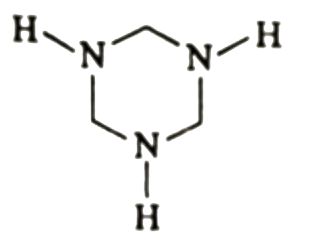Formaldehyde reacts with excess of ammonia to give
CH2=NH


Hexamethylenetetramine
The correct Answer is:D
To solve the question regarding the reaction of formaldehyde with excess ammonia, we can follow these steps:
Step 1: Identify the Reactants
- The reactants in this reaction are formaldehyde (HCHO) and ammonia (NH3).
Step 2: Understand the Reaction
- When formaldehyde reacts with ammonia, it undergoes a condensation reaction. In this case, since there is excess ammonia, it will lead to the formation of a more complex product.
Step 3: Determine the Product
- The major product formed when formaldehyde reacts with excess ammonia is hexamethylenetetramine (also known as urotropine). The molecular formula for hexamethylenetetramine is C6H12N4.
Step 4: Write the Balanced Reaction
- The balanced chemical equation for the reaction can be represented as follows:
6HCHO+4NH3→C6H12N4+6H2O
- This shows that 6 moles of formaldehyde and 4 moles of ammonia react to produce 1 mole of hexamethylenetetramine and 6 moles of water.
Step 5: Draw the Structure of the Product
- The structure of hexamethylenetetramine consists of a central carbon atom bonded to six methylene (-CH2-) groups, with four nitrogen atoms also bonded to the carbon framework.
Conclusion
- Therefore, the final answer to the question is that formaldehyde reacts with excess ammonia to give hexamethylenetetramine.
---
- The reactants in this reaction are formaldehyde (HCHO) and ammonia (NH3).
- When formaldehyde reacts with ammonia, it undergoes a condensation reaction. In this case, since there is excess ammonia, it will lead to the formation of a more complex product.
- The major product formed when formaldehyde reacts with excess ammonia is hexamethylenetetramine (also known as urotropine). The molecular formula for hexamethylenetetramine is C6H12N4.
- The balanced chemical equation for the reaction can be represented as follows:
6HCHO+4NH3→C6H12N4+6H2O
- This shows that 6 moles of formaldehyde and 4 moles of ammonia react to produce 1 mole of hexamethylenetetramine and 6 moles of water.
- The structure of hexamethylenetetramine consists of a central carbon atom bonded to six methylene (-CH2-) groups, with four nitrogen atoms also bonded to the carbon framework.
- Therefore, the final answer to the question is that formaldehyde reacts with excess ammonia to give hexamethylenetetramine.
Topper's Solved these Questions
Similar Questions
Knowledge Check
Ethyl iodide reacts with excess ammonia to give
AEthyl amineBDiethyl amineCTriethyl amineDTetraethyl ammonium iodideFormaldehyde reacts with excess of ammonia to give
Ahexamethylene tetramineBformaldehyde ammoniaCformalinDmethylamineFormaldehyde racts with ammonia to give urotropine. The formula of urotropine is
A(CH2)6N4B(CH2)4N3C(CH2)6N6D(CH2)3N3
Chlorine reacts with excess of ammonia to form.
View SolutionAcetic anhydride reacts with excess of ammonia to from
View SolutionAn haloalkane is made to react with excess of alcoholic ammonia to give mainly
View SolutionAn halokane is made to treat with excess of alcholic ammonia to give mainly
View SolutionAmmonia reacts with excess of chlorine to give
View Solution
